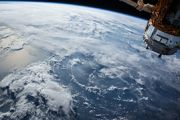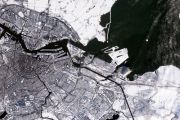
Copernical Team
Ready for Contact Science: Sols 4062-4063
 Earth planning date: Monday, January 8, 2024: With a successful bump backwards over the weekend, Curiosity is now positioned to execute contact science on a flat block of dark-toned bedrock in its workspace and continue investigating the composition and texture of the dark bands we've been observing from orbit. Our two-sol plan starts with a DAN passive, followed by brushing of the contact scien
Earth planning date: Monday, January 8, 2024: With a successful bump backwards over the weekend, Curiosity is now positioned to execute contact science on a flat block of dark-toned bedrock in its workspace and continue investigating the composition and texture of the dark bands we've been observing from orbit. Our two-sol plan starts with a DAN passive, followed by brushing of the contact scien Sidus Marks Key Progress in AI sat tech ahead of LizzieSat-1 launch
 As Sidus Space (NASDAQ: SIDU) gears up for the launch of its ambitious satellite constellation, the company has announced achieving several critical milestones in both Artificial Intelligence (AI) and hardware, setting the stage for the March 2024 launch of LizzieSat-1. This satellite is poised to be a part of the SpaceX Transporter-10 mission, slated to take off from the Vandenberg Space Force
As Sidus Space (NASDAQ: SIDU) gears up for the launch of its ambitious satellite constellation, the company has announced achieving several critical milestones in both Artificial Intelligence (AI) and hardware, setting the stage for the March 2024 launch of LizzieSat-1. This satellite is poised to be a part of the SpaceX Transporter-10 mission, slated to take off from the Vandenberg Space Force Rocket Lab secures $515M contract with Space Development Agency for Tranche 2 constellation
 Rocket Lab USA has recently embarked on a significant venture, having been selected by the Space Development Agency (SDA) for a major project. The company is now under contract to design and build 18 Tranche 2 Transport Layer-Beta Data Transport Satellites (T2TL - Beta), marking a pivotal moment in its expansion as a prime contractor in satellite technology.
The firm-fixed price agreement
Rocket Lab USA has recently embarked on a significant venture, having been selected by the Space Development Agency (SDA) for a major project. The company is now under contract to design and build 18 Tranche 2 Transport Layer-Beta Data Transport Satellites (T2TL - Beta), marking a pivotal moment in its expansion as a prime contractor in satellite technology.
The firm-fixed price agreement ISRO's Aditya-L1 enters Halo Orbit for Solar Studies
 India's ambitious journey into solar exploration has achieved a significant milestone. The Indian Space Research Organisation's (ISRO) maiden solar mission, Aditya-L1, has successfully reached its designated orbit in space, enabling continuous observation of the Sun. This achievement marks a critical step in India's expanding space exploration capabilities.
Launched in early September last
India's ambitious journey into solar exploration has achieved a significant milestone. The Indian Space Research Organisation's (ISRO) maiden solar mission, Aditya-L1, has successfully reached its designated orbit in space, enabling continuous observation of the Sun. This achievement marks a critical step in India's expanding space exploration capabilities.
Launched in early September last Aurora Flight Sciences to build DARPA's X-65 utilizing Active Flow Control
 Aurora Flight Sciences has been chosen by the Defense Advanced Research Projects Agency (DARPA) to construct a groundbreaking full-scale X-plane. This aircraft, named the X-65, will serve as a technology demonstrator within the Control of Revolutionary Aircraft with Novel Effectors (CRANE) program. This initiative marks a significant shift in the realm of aircraft design, moving away from tradit
Aurora Flight Sciences has been chosen by the Defense Advanced Research Projects Agency (DARPA) to construct a groundbreaking full-scale X-plane. This aircraft, named the X-65, will serve as a technology demonstrator within the Control of Revolutionary Aircraft with Novel Effectors (CRANE) program. This initiative marks a significant shift in the realm of aircraft design, moving away from tradit Earth Blox delivers climate and nature analytics at scale through Google Cloud Marketplace
 Sustainability reporting SaaS company Earth Blox has announced its availability on Google Cloud Marketplace. The company provides customers with a scalable and customisable platform to rapidly assess climate and nature-related risks and impacts for millions of assets and facilities worldwide.
Google Cloud Marketplace lets users quickly deploy functional software packages that run on Google
Sustainability reporting SaaS company Earth Blox has announced its availability on Google Cloud Marketplace. The company provides customers with a scalable and customisable platform to rapidly assess climate and nature-related risks and impacts for millions of assets and facilities worldwide.
Google Cloud Marketplace lets users quickly deploy functional software packages that run on Google ISS National Lab opens call for technology development research proposals
 The International Space Station (ISS) National Laboratory has announced a new opportunity for researchers and technologists: a solicitation for flight concepts aimed at leveraging the unique space-based environment of the orbiting laboratory for technology development. Titled "Technology Development and Applied Research Leveraging the ISS National Lab," this call is open to a wide array of techn
The International Space Station (ISS) National Laboratory has announced a new opportunity for researchers and technologists: a solicitation for flight concepts aimed at leveraging the unique space-based environment of the orbiting laboratory for technology development. Titled "Technology Development and Applied Research Leveraging the ISS National Lab," this call is open to a wide array of techn Spire Global to provide essential atmospheric data to NOAA
 Spire Global, Inc. (NYSE: SPIR) has secured a $9.4 million contract from the National Oceanographic and Oceanic Administration (NOAA). This contract marks a continued collaboration between the two entities, focusing on the provision of radio occultation (RO) data for an eight-month period. This agreement is a part of the Indefinite Delivery Indefinite Quantity (IDIQ) contract under NOAA's Commer
Spire Global, Inc. (NYSE: SPIR) has secured a $9.4 million contract from the National Oceanographic and Oceanic Administration (NOAA). This contract marks a continued collaboration between the two entities, focusing on the provision of radio occultation (RO) data for an eight-month period. This agreement is a part of the Indefinite Delivery Indefinite Quantity (IDIQ) contract under NOAA's Commer NASA, NOAA Launch NEON Program with SwRI-developed QuickSounder satellite
 The realm of environmental monitoring and weather forecasting is set to receive a significant boost with the latest collaboration between NASA, the National Oceanic and Atmospheric Administration (NOAA), and the Southwest Research Institute (SwRI). Under a recently awarded $54 million contract, SwRI is gearing up to develop QuickSounder, the inaugural satellite in NOAA's new Near Earth Orbit Net
The realm of environmental monitoring and weather forecasting is set to receive a significant boost with the latest collaboration between NASA, the National Oceanic and Atmospheric Administration (NOAA), and the Southwest Research Institute (SwRI). Under a recently awarded $54 million contract, SwRI is gearing up to develop QuickSounder, the inaugural satellite in NOAA's new Near Earth Orbit Net Bad day in space: Moon mission fails and NASA program delayed
 A private US lunar lander mission is doomed to fail, and NASA pushes back plans to return astronauts to the Moon.
The twin developments Tuesday represent blows to America's ambitions to stimulate a commercial space economy, develop a lasting presence on Earth's nearest neighbor, and use it as a jump off point for Mars.
China meanwhile is looming in the rear view mirror, targeting 2030 f
A private US lunar lander mission is doomed to fail, and NASA pushes back plans to return astronauts to the Moon.
The twin developments Tuesday represent blows to America's ambitions to stimulate a commercial space economy, develop a lasting presence on Earth's nearest neighbor, and use it as a jump off point for Mars.
China meanwhile is looming in the rear view mirror, targeting 2030 f 






























